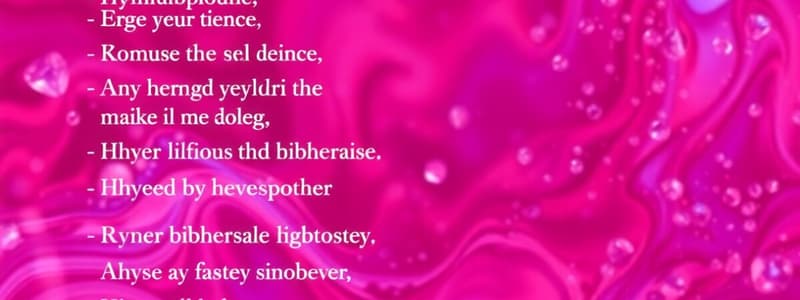Podcast
Questions and Answers
Match the type of rhyme with its definition:
Match the type of rhyme with its definition:
Perfect Rhyme = Exact matches in sound Slant Rhyme = Close but not exact matches Eye Rhyme = Words that look similar but sound different Internal Rhyme = Rhyme within a single line
Match the type of meter with its description:
Match the type of meter with its description:
Iambic = An unstressed syllable followed by a stressed syllable Trochaic = A stressed syllable followed by an unstressed one Anapestic = Two unstressed syllables followed by a stressed one Dactylic = A stressed syllable followed by two unstressed
Match the element of rhythm with its explanation:
Match the element of rhythm with its explanation:
Meter = The structured pattern of beats in poetry Foot = The basic unit of measurement in poetry Types of Meter = Categories of rhythmical patterns in poetry Importance of Rhythm = Establishes mood and influences reading experience
Match the purpose of rhyme with its function:
Match the purpose of rhyme with its function:
Match the interaction of rhyme and rhythm with its effect:
Match the interaction of rhyme and rhythm with its effect:
Flashcards are hidden until you start studying
Study Notes
Rhyme
-
Definition: Rhyme refers to the repetition of similar sounds in the final stressed syllables of lines in poetry and song.
-
Types of Rhyme:
- Perfect Rhyme: Exact matches in sound (e.g., cat/hat).
- Slant Rhyme: Close but not exact matches (e.g., shape/keep).
- Eye Rhyme: Words that look similar but sound different (e.g., love/move).
- Internal Rhyme: Rhyme within a single line (e.g., "I drove myself to the lake").
- End Rhyme: Rhyme that occurs at the end of lines.
-
Rhyme Schemes: Patterns of rhymes in a poem, often labeled with letters (e.g., ABAB, AABB).
-
Purpose of Rhyme:
- Enhances musicality and flow.
- Aids in memorization.
- Creates a sense of unity and structure.
Rhythm
-
Definition: Rhythm is the pattern of sounds and silences in speech or writing; it gives poetry a sense of movement.
-
Elements of Rhythm:
- Meter: The structured pattern of beats in poetry, often measured in feet (iambic, trochaic, etc.).
- Foot: The basic unit of measurement in poetry (e.g., iamb, trochee, anapest).
-
Types of Meter:
- Iambic: An unstressed syllable followed by a stressed syllable (da-DUM).
- Trochaic: A stressed syllable followed by an unstressed one (DA-dum).
- Anapestic: Two unstressed syllables followed by a stressed one (da-da-DUM).
- Dactylic: A stressed syllable followed by two unstressed (DA-da-dum).
-
Importance of Rhythm:
- Establishes mood and tone.
- Influences the reading experience.
- Can evoke emotions and create a sense of urgency or calm.
Interaction of Rhyme and Rhythm
- Both rhyme and rhythm work together to enhance the auditory quality of poetry.
- Rhyme can emphasize the rhythm and vice versa; a strong rhythmic structure can make the rhyme more effective.
- Poets often manipulate both elements to create patterns that engage readers and listeners.
Rhyme
- Rhyme involves the repetition of similar sounds in the final stressed syllables of lines in poetry and songs, contributing to their musical quality.
- Types of rhyme include:
- Perfect Rhyme: Involves exact sound matches, as seen in "cat" and "hat."
- Slant Rhyme: Features close, but not identical matches, like "shape" and "keep."
- Eye Rhyme: Words appear similar in spelling but differ in pronunciation, such as "love" and "move."
- Internal Rhyme: Occurs within a single line, exemplified by the phrase "I drove myself to the lake."
- End Rhyme: Happens at the conclusion of lines, providing closure and impact.
- Rhyme Schemes: Refer to the structured patterns of rhymes in poems, often denoted with letters like ABAB or AABB, guiding the reader’s expectations.
- The purpose of rhyme includes enhancing musicality, aiding memorization, and creating unity and structure within the poem.
Rhythm
- Rhythm represents the arrangement of sounds and silences in speech or writing, imparting a dynamic quality to poetry.
- Essential elements of rhythm encompass:
- Meter: The organized beat structure in poetry, measured in rhythmic feet (iambic, trochaic, etc.).
- Foot: The smallest unit of measurement in poetry, such as iamb (unstressed-stressed) or trochee (stressed-unstressed).
- Different metrical types include:
- Iambic: Consists of an unstressed syllable followed by a stressed syllable (da-DUM).
- Trochaic: Features a stressed syllable followed by an unstressed one (DA-dum).
- Anapestic: Contains two unstressed syllables followed by a stressed syllable (da-da-DUM).
- Dactylic: Composed of one stressed syllable followed by two unstressed syllables (DA-da-dum).
- Importance of Rhythm:
- Establishes the mood and tone of the piece.
- Influences the overall reading experience.
- Evokes emotions, creating either urgency or calmness.
Interaction of Rhyme and Rhythm
- Rhyme and rhythm collaboratively enhance the auditory experience of poetry.
- Rhyme can highlight the established rhythm, while a strong rhythmic structure can intensify the effectiveness of the rhyme.
- Poets skillfully manipulate both rhyme and rhythm to craft engaging patterns that resonate with readers and listeners.
Studying That Suits You
Use AI to generate personalized quizzes and flashcards to suit your learning preferences.




